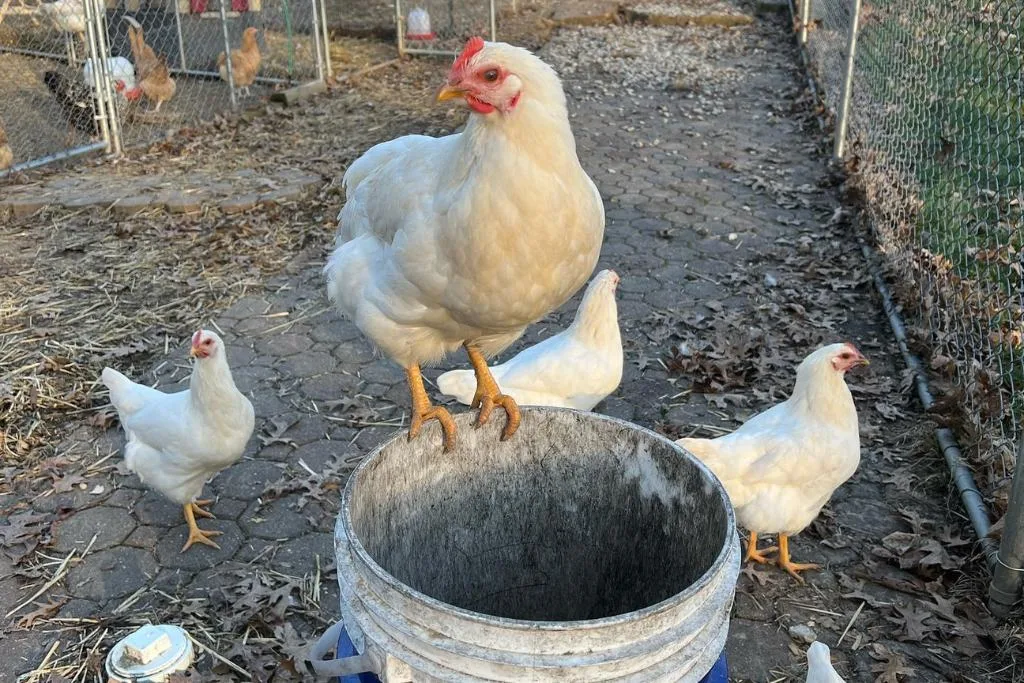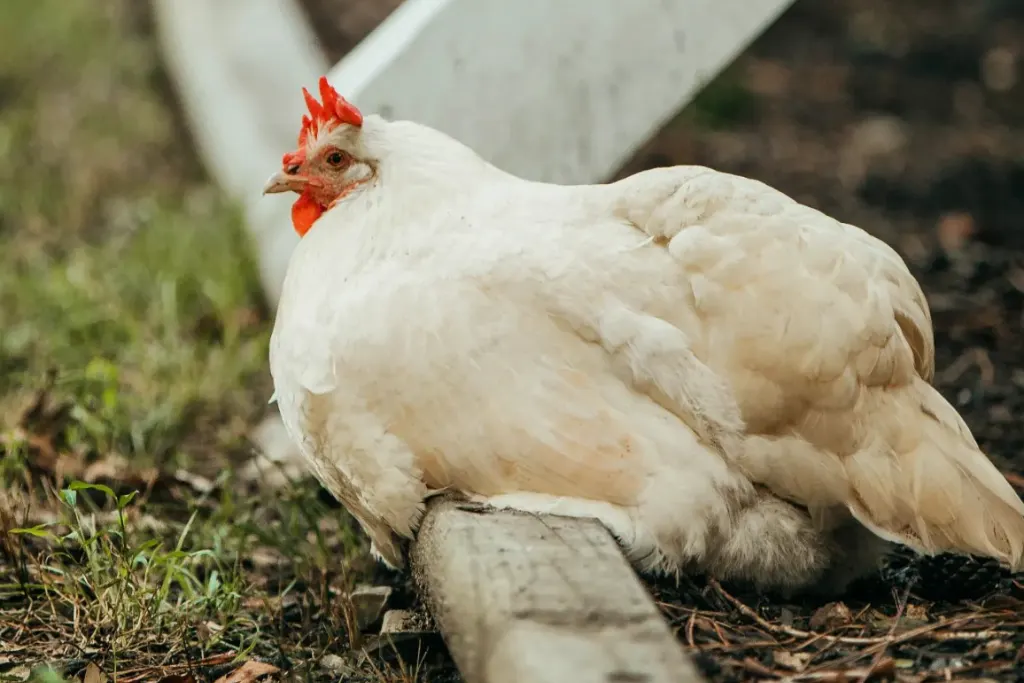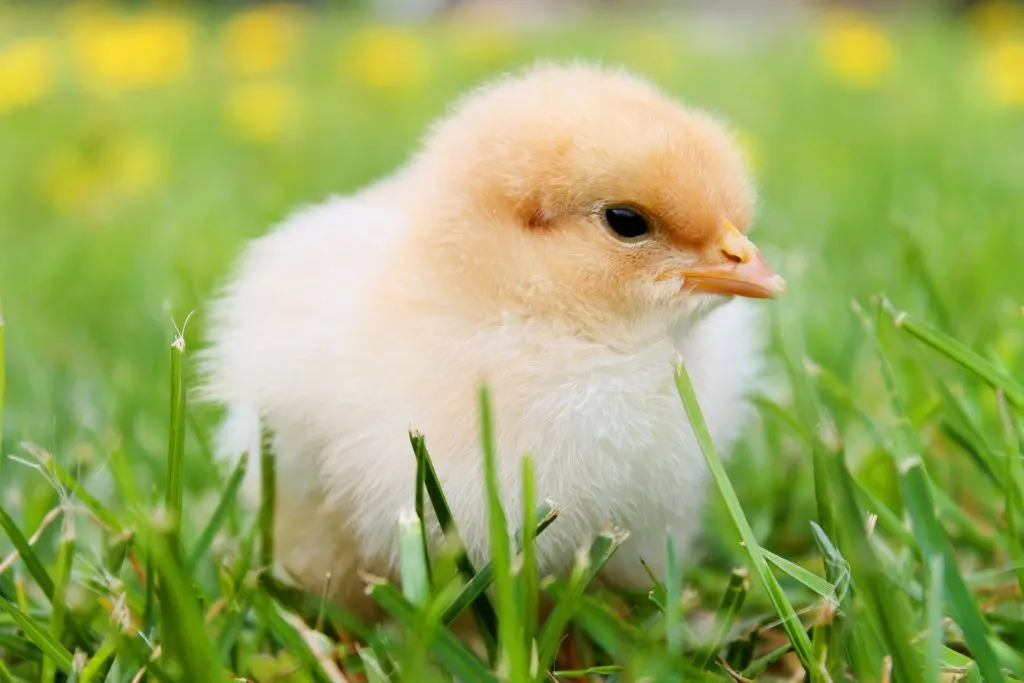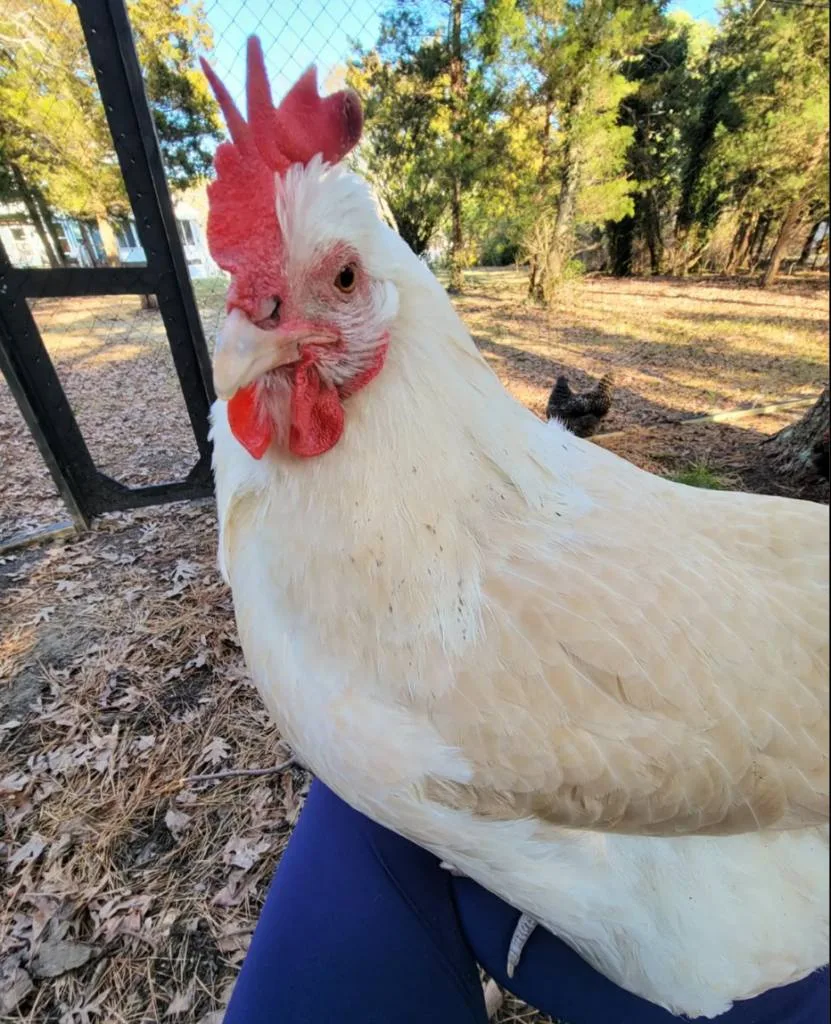Looking to add a beautiful hybrid chicken breed to your flock? The Amberlink Chicken breed just might be for you.
Amberlink chickens are unique and excellent for beginners due to their inherently docile personalities and great egg production. They also have gorgeous white and amber feathers, making them a beautiful addition to any flock.
However, there are some things to consider before owning this type of chicken.
In this post, we will provide the complete breed and care guide for the Amberlink chicken.
We will discuss:
- Amberlink chicken history
- Hybrid chicken pros and cons
- Amberlink chicken personality
- And how to properly care for these birds
After this post, you will have a better understanding of the Amberlink chicken breed and can then decide whether these birds are suitable for you and your flock.

Amberlink Chicken Overview
Below is a table with an overview of the Amberlink Chicken:
| Lifespan | 3-4 years |
| Weight | 4-6 pounds each |
| Appearance | White/Amber feathers |
| Egg Color | Brown |
| Egg Production | About 270 eggs per year |
| Broodiness Level | Low |
| Beginner Friendly | Medium |
| Space Needed | 4 square feet inside the coop, 10 square feet outside |
| Price | $2-$5 per chick |
Amberlink Chicken History
Amberlink chickens, or Amber Sex Link Chickens, are considered hybrid chickens.
Hybrid chickens are a mix of two different pure breeds.
Amberlink chickens are a mix between Rhode Island Reds and White Island Reds or White Plymouth Rocks.
Mixing these pure breeds doesn’t always guarantee you will get an Amberlink chicken, however.
The process can be complex and random. Most of the time, the chicks will become one of the parent breeds instead of the intended hybrid.
Breeding two Amberlinks together also won’t result in more Amberlink chicks.
This is due to the complex hybrid breeding process. Amberlink genes are so complex that it is very difficult to breed them, making them a little more difficult to come by.
Hybrid Chickens Pros and Cons
Hybrid chickens have several pros, but owning them can also have several downsides.
It is important to consider all of the pros and cons when considering a hybrid breed for your flock.
Pros
- Hybrids have high egg-laying production
- Amberlink chickens and other hybrids don’t typically become broody
- They can have great personalities
- Very beautiful and unique in size and color
- Hybrids can sometimes lay eggs year-round (even during the winter and colder months)
Cons
- Hybrid chickens have a much shorter lifespan than pure breeds (their life expectancy is around 2-4 years, compared to some pure breeds who can live up to 10 years)
- Egg production drops after about 1.5-2 years old
- Amberlink chickens and other hybrids are more prone to health concerns such as egg-peritonitis, egg-binding, and prolapse
- Hybrids aren’t always the best option if you are breeding for meat
- Hybrid hens are not great at parenting, so you will need to incubate your own eggs if looking to raise chicks
- Hybrid chicken breeding is complex and time-consuming, and you won’t always get more hybrids when breeding
Some chicken keepers dislike owning hybrid chickens and some say they are great.
It is important to weigh the pros and cons for yourself when determining if hybrid chickens are right for you and your flock.

Amberlink Chicken Lifespan
Unfortunately, hybrid chickens do not live nearly as long as pure-breed chickens.
Purebred chickens can live anywhere between 8 and 10 years if cared for properly.
That means that the Amberlink chicken lifespan is around 3 to 4 years if properly cared for.
Amberlink Chicken Appearance
Amberlink chickens are beautiful, but it can be difficult to distinguish them from other breeds with white feathers such as the Delaware chicken.
When they are adults, you can differentiate Amberlinks by the amber speckles that appear throughout their feathers.
Here are some other facts on Amberlink chicken appearance:
Amberlink Chicken Eggs
Amberlink chickens lay eggs that are medium to dark brown.
They typically lay large eggs (50 grams – 75 grams each), which are great for eating.
Amberlink Chicks
Amberlink chicks look the same after they first hatch out of the egg, regardless of whether they are male or female.
When they first hatch (and up to a few weeks after), they will be completely covered in fuzzy yellow feathers.
During the pullets and cockerels phase (between 5-7 weeks old), you will start to see some changes in the feathers and will most likely be able to determine the gender.
Female Amberlink chicks (pullets) will start to get some amber speckles in their white feathers. Male Amberlink chicks (cockerels) will become significantly more amber in color, with color growing darker around their necks and backs first.

Amberlink Chicken Adults
Male and female Amberlink chickens range in size, with females typically being larger than males. This is because the females are bred to have high egg production.
Amberlink hens weigh around 6 pounds, while males weigh between 4-5 pounds each.
Female Amberlink adults have soft white feathers with flecks of amber feathers on their wings, tails, and necks.
Amberlink roosters (males) grow up to have dark amber speckles on their back, chest, and neck upon maturity.
Amberlink Chicken Temperament & Personality
Amberlink chickens have wonderful personalities, making them a great option for chicken keepers looking for a friendly breed to add to their flock.
Amberlink chicken’s temperament is typically described as:
- Friendly
- Playful
- Curious
- Docile
- Gentle
Even male Amberlinks tend to have these traits.
Amberlink chickens are also great to have around the yard because they are fairly easy-going and will get along with other animals.
You can add them to your existing flock, however, it is typically recommended to place them with other gentle or docile breeds to avoid any aggression toward them.
Here are some of the best breeds to mix with your Amberlinks:
- Silkies
- Plymouth Rocks
- Cochin
- Rhode Island Reds
- Speckled Sussex
- Buff Orpington
These are all great options to build a fun and friendly flock that all get along together.
Egg Laying
Since Amberlink chickens are hybrids, they will start laying eggs within the first year of life.
This breed is altered to have a high egg production, so you can expect several eggs per week, or around 270 eggs per year once they reach maturity.
Amberlink chickens will lay year-round, even during the winter.
This may sound great overall, but keep in mind that during their second year of life, Amberlink egg production can drop by as much as 20%, and they tend to stop laying in year 3 altogether.

Care Requirements
Amberlink chickens are very friendly and can be easy to care for. They have fairly basic care requirements and will thrive with proper handling, feeding, and housing.
However because they are hybrids, they sometimes require a bit more love and care than some other breeds.
Feeding
Amberlink chickens are happiest and healthiest when fed a proper diet.
Their diet requires lots of protein and calcium.
For the first few weeks of life, Amberlink chicks should eat a chick starter feed containing 18% to 24% protein.
This is the necessary feed through their first 6 weeks.
Upon maturity, you can start to feed Amberlink chicken adults a feed containing 16% to 18% protein.
Just like with other mature hens, Amberlink hens require a healthy dose of calcium to keep their eggs strong and healthy.
This can be provided by offering them crushed oyster shells or black fly larvae separate from their typical feed.
Amberlink chicken adults also benefit from additional vitamins found in probiotics, cod liver oil, and mealworms.
It is important not to overfeed your Amberlinks, however, because it can cause health concerns that are typically found with hybrid chickens (such as prolapse).
Housing
Amberlink chickens need lots of space to forage and move around freely. If they don’t have proper space to do so, they can become stressed and unhealthy.
Each Amberlink chicken requires 4 square feet minimum inside their coop and about 10 square feet minimum if free-ranging.
Although it will never hurt to provide them with more space if it’s available.
Nesting boxes inside the coop will typically hold about 2-3 hens, depending on their size. Allow a few different heights in perches with enough room so that they always feel comfortable.
Amberlinks can also become stressed if they do not feel safe in their environment. Their coop should be secure to keep out predators. It is good practice to lock up your chickens in their coop at night since that is when most predators will be out hunting.
You may also consider securing the area in which you allow your chickens to roam to keep predators out during the day as well. This may not be possible if you are looking to free-range your chickens, however. In this case, skip the fence and just make sure to properly secure them overnight.
Free-Ranging
There are some items to keep in mind when free-ranging your Amberlink chickens.
First, if you do not have a fence or roof to protect them while they are out of the coop, they may still get attacked by predators during the day. Birds of prey, stray dogs, and other large animals come out in broad daylight and will hunt your chickens if they aren’t protected.
Second, free-range time allows for additional nutrients in your chicken’s diet, but free-ranging should not take the place of their actual feed.
Temperature
One of the benefits of owning Amberlinks is that they are very tolerant of both hot and cold weather. Amberlink chickens lay year-round, regardless of how cold it is outside.
You may want to consider a coop heater inside their coop, however. Even the most healthy and durable chickens can become sick at times.
In the summer, they will also need plenty of water and a place to get out of the sun periodically throughout the day.
Health Concerns
Hybrid chickens tend to be more susceptible to health concerns than pure-breed chickens.
Their high egg production rate places a lot of strain on their bones and bodies. This is also why they have shorter lifespans than purebred chickens.
Here are some of the most common Amberlink chicken health concerns to be aware of:
Egg-Binding
Egg-binding is when a hen gets an egg stuck inside her oviduct.
This happens more often with hybrid chickens because they lay more eggs than purebreds.
Egg-binding can be life-threatening. At times, the hen will need to be taken to the vet to treat the issue, but sometimes giving the chicken some added calcium, water, or a warm bath can help the hen pass the egg.
Prolapse
Prolapse is the result of the hen’s oviduct turning inside out. Laying hundreds of eggs every year places a lot of stress on the hen’s reproductive system.
This issue can be treated, but if it occurs once, it is most likely going to happen again. If the issue is left untreated, there is a chance the hen won’t make it. It is important to treat prolapse as soon as it is found.
Typically a diet change will help prevent prolapse.
Egg Peritonitis
Egg Peritonitis occurs when a yolk enters the cavity body of the hen.
This issue can be much more difficult to spot, but you will see an inflamed area where the yolk is stuck in the body. A hen typically has other symptoms along with inflammation such as swelling in the abdominal area and overall discomfort.
This is a serious health concern and needs to be treated with antibiotics from the veterinarian’s office. If it is left untreated, the chicken most likely won’t make it.
Final Thoughts
If you are searching for a beautiful, easy-going, and docile chicken for your flock, the Amberlink chicken is a great option.
However, there are some downsides to owning this breed of chicken, such as a short lifespan and severe health concerns.
But if you can look past some of the downsides that come along with owning a hybrid chicken breed, Amberlinks are a great option.
Still not sure whether the Amberlink chicken is right for you? Keep reading below for some frequently asked questions about the breed.
Amberlink Chickens FAQs
Are Amberlink chickens broody?
Although they can inherit some broody behaviors, the answer is no, Amberlink chickens rarely go broody.
This is due to their high egg-laying production. They are so busy producing new eggs that the hens don’t have time to incubate their own eggs and care for their chicks.
Therefore if your goal is to breed and raise chicks, you will need to collect the fertilized eggs and incubate them yourself.
When do Amberlink chickens start laying eggs?
Amberlink chickens start laying eggs within the first year of life. Upon maturity, they will lay several eggs per week, or around 270 eggs per year.
Their first year of laying may be slightly sporadic but will become more steady during their second year of life.
Can Amberlink chickens live with other birds?
Yes, Amberlink chickens are very docile and friendly and get along well with other animals.
It is best to keep them in an enclosure with other docile and friendly birds, otherwise, they can be bullied.
Here are some of the best breeds to house with Amberlinks:
- Silkies
- Plymouth Rocks
- Cochin
- Rhode Island Reds
- Speckled Sussex
- Buff Orpington

